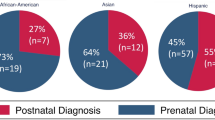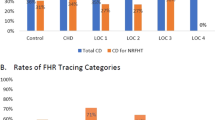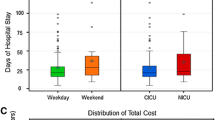Abstract
Prenatal diagnosis of critical congenital heart disease (CHD) is associated with decreased morbidity. It is also associated with lower birth weights and earlier gestational age at delivery. The University of California Fetal Consortium (UCfC) comprises five tertiary medical centers, and was created to define treatment practices. We utilized this consortium to assess delivery patterns and outcomes in subjects with prenatal and postnatal diagnosis of CHD. A retrospective cohort study was conducted on maternal–neonatal pairs diagnosed with complex CHD prenatally (n = 186) and postnatally (n = 110) from 2011 to 2013. Outcomes were assessed between groups after adjusting for disease severity. Prenatally diagnosed subjects were born earlier (38.1 ± 0.11 vs. 39 ± 0.14 weeks, p = < 0.001), and had lower birth weights (2853 ± 49 vs. 3074 ± 58 g, p = 0.005) as compared to postnatal diagnosis. For every week increase in gestational age and 100 g increase in birth weight, length of stay decreased by 12.3 ± 2.7% (p < 0.001) and 3.9 ± 0.9% (p < 0.001). Subjects with prenatal diagnosis were more often born via cesarean both planned (35.6 vs. 26.2%, p = 0.004) and after a trial of labor (13 vs. 7.8%, p = 0.017). Neonates with cesarean delivery trended toward a longer length of stay (2.6 days longer), and were born earlier as compared to other modalities (37.7 ± 0.22 weeks, p = 0.001). Management after prenatal diagnosis of CHD appears to have modifiable disadvantages for maternal and neonatal outcomes. The UCfC provides a platform to study best practices and standardization of care for future studies.



Similar content being viewed by others
References
Fetal Echocardiography Task Force, American Institute of Ultrasound in Medicine Clinical Standards Committee, American College of Obstetricians and Gynecologists, Society for Maternal-Fetal Medicine (2011) AIUM practice guideline for the performance of fetal echocardiography. J Ultrasound Med 30:127–136.
International Society of Ultrasound in Obstetrics and Gynecology, Carvalho JS, Allan LD et al (2013) ISUOG Practice Guidelines (updated): sonographic screening examination of the fetal heart. Ultrasound Obstet Gynecol 41:348–359. doi:10.1002/uog.12403
Tometzki AJ, Suda K, Kohl T, et al (1999) Accuracy of prenatal echocardiographic diagnosis and prognosis of fetuses with conotruncal anomalies. JAC 33:1696–1701.
Allan LD, Sharland GK, Milburn A, et al (1994) Prospective diagnosis of 1006 consecutive cases of congenital heart disease in the fetus. JAC 23:1452–1458.
Donofrio MT, Moon-Grady AJ, Hornberger LK et al (2014) Diagnosis and treatment of fetal cardiac disease: a scientific statement from the American Heart Association. Circulation 129:2183–2242. doi:10.1161/01.cir.0000437597.44550.5d
Morris SA, Ethen MK, Penny DJ et al (2014) Prenatal diagnosis, birth location, surgical center, and neonatal mortality in infants with hypoplastic left heart syndrome. Circulation 129:285–292. doi:10.1161/CIRCULATIONAHA.113.003711
Tworetzky W, McElhinney DB, Reddy VM et al (2001) Improved surgical outcome after fetal diagnosis of hypoplastic left heart syndrome. Circulation 103:1269–1273
Kipps AK, Feuille C, Azakie A et al (2011) Prenatal diagnosis of hypoplastic left heart syndrome in current era. Am J Cardiol 108:421–427. doi:10.1016/j.amjcard.2011.03.065
Mahle WT, Clancy RR, McGaurn SP et al (2001) Impact of prenatal diagnosis on survival and early neurologic morbidity in neonates with the hypoplastic left heart syndrome. Pediatrics 107:1277–1282
Kumar RK, Newburger JW, Gauvreau K, et al (1999) Comparison of outcome when hypoplastic left heart syndrome and transposition of the great arteries are diagnosed prenatally versus when diagnosis of these two conditions is made only postnatally. AJC 83:1649–1653.
Friedberg MK, Silverman NH, Moon-Grady AJ et al (2009) Prenatal detection of congenital heart disease. J Pediatr 155(26-31-31):e1. doi:10.1016/j.jpeds.2009.01.050
Oster ME, Kim CH, Kusano AS et al (2014) A population-based study of the association of prenatal diagnosis with survival rate for infants with congenital heart defects. Am J Cardiol 113:1036–1040. doi:10.1016/j.amjcard.2013.11.066
Wright LK, Ehrlich A, Stauffer N et al (2014) Relation of prenatal diagnosis with one-year survival rate for infants with congenital heart disease. Am J Cardiol 113:1041–1044. doi:10.1016/j.amjcard.2013.11.065
Calderon J, Angeard N, Moutier S et al (2012) Impact of prenatal diagnosis on neurocognitive outcomes in children with transposition of the great arteries. J Pediatr 161(94–8):e1. doi:10.1016/j.jpeds.2011.12.036
Peyvandi S, De Santiago V, Chakkarapani E, et al (2016) Association of prenatal diagnosis of critical congenital heart disease with postnatal brain development and the risk of brain injury. JAMA Pediatr. doi:10.1001/jamapediatrics.2015.4450
Levey A, Glickstein JS, Kleinman CS et al (2010) The impact of prenatal diagnosis of complex congenital heart disease on neonatal outcomes. Pediatr Cardiol 31:587–597. doi:10.1007/s00246-010-9648-2
Costello JM, Pasquali SK, Jacobs JP et al (2014) Gestational age at birth and outcomes after neonatal cardiac surgery: an analysis of the society of thoracic surgeons congenital heart surgery database. Circulation 129:2511–2517. doi:10.1161/CIRCULATIONAHA.113.005864
Goff DA, Luan X, Gerdes M et al (2012) Younger gestational age is associated with worse neurodevelopmental outcomes after cardiac surgery in infancy. J Thorac Cardiovasc Surg 143:535–542. doi:10.1016/j.jtcvs.2011.11.029
Jenkins KJ, Gauvreau K, Newburger JW, et al (2002) Consensus-based method for risk adjustment for surgery for congenital heart disease. J Thorac Cardiovasc Surg 123 110–118
Fenton TR, Kim JH (2013) A systematic review and meta-analysis to revise the Fenton growth chart for preterm infants. BMC Pediatr 13:59. doi:10.1186/1471-2431-13-59
Peterson AL, Quartermain MD, Ades A et al (2011) Impact of mode of delivery on markers of perinatal hemodynamics in infants with hypoplastic left heart syndrome. J Pediatr 159:64–69. doi:10.1016/j.jpeds.2011.01.004
Trento LU, Pruetz JD, Chang RK et al (2012) Prenatal diagnosis of congenital heart disease: impact of mode of delivery on neonatal outcome. Prenat Diagn 32:1250–1255. doi:10.1002/pd.3991
Hannah ME, Hannah WJ, Hewson SA et al (2000) Planned caesarean section versus planned vaginal birth for breech presentation at term: a randomised multicentre trial. Term breech trial collaborative group. Lancet 356:1375–1383
Minkoff H, Chervenak FA (2003) Elective primary cesarean delivery. N Engl J Med 348:946–950. doi:10.1056/NEJMsb022734
Silver RM, Landon MB, Rouse DJ et al (2006) Maternal morbidity associated with multiple repeat cesarean deliveries. Obstet Gynecol 107:1226–1232. doi:10.1097/01.AOG.0000219750.79480.84
Lydon-Rochelle M, Holt VL, Martin DP, Easterling TR (2000) Association between method of delivery and maternal rehospitalization. JAMA 283:2411–2416
Snyder CC, Wolfe KB, Loftin RW et al (2011) The influence of hospital type on induction of labor and mode of delivery. Am J Obstet Gynecol 205(346):e1–e4. doi:10.1016/j.ajog.2011.05.004
Seyb ST, Berka RJ, Socol ML, Dooley SL (1999) Risk of cesarean delivery with elective induction of labor at term in nulliparous women. Obstet Gynecol 94:600–607
Maslow AS, Sweeny AL (2000) Elective induction of labor as a risk factor for cesarean delivery among low-risk women at term. Obstet Gynecol 95:917–922
Cammu H, Martens G, Ruyssinck G, Amy J-J (2002) Outcome after elective labor induction in nulliparous women: a matched cohort study. Am J Obstet Gynecol 186:240–244
Yeast JD, Jones A, Poskin M (1999) Induction of labor and the relationship to cesarean delivery: a review of 7001 consecutive inductions. Am J Obstet Gynecol 180:628–633
Sheiner E, Sarid L, Levy A et al (2005) Obstetric risk factors and outcome of pregnancies complicated with early postpartum hemorrhage: a population-based study. J Matern Fetal Neonatal Med 18:149–154. doi:10.1080/14767050500170088
Vrouenraets FPJM, Roumen FJME, Dehing CJG et al (2005) Bishop score and risk of cesarean delivery after induction of labor in nulliparous women. Obstet Gynecol 105:690–697. doi:10.1097/01.AOG.0000152338.76759.38
Kaufman KE, Bailit JL, Grobman W (2002) Elective induction: an analysis of economic and health consequences. Am J Obstet Gynecol 187:858–863
Allen VM, O’Connell CM, Farrell SA, Baskett TF (2005) Economic implications of method of delivery. Am J Obstet Gynecol 193:192–197. doi:10.1016/j.ajog.2004.10.635
Ueda K, Ikeda T, Iwanaga N et al (2009) Intrapartum fetal heart rate monitoring in cases of congenital heart disease. Am J Obstet Gynecol 201(64):e1–e6. doi:10.1016/j.ajog.2009.03.015
Morikawa M, Endo D, Yamada T et al (2014) Electronic fetal heart rate monitoring in five fetuses with Ebstein’s anomaly. J Obstet Gynaecol Res 40:424–428. doi:10.1111/jog.12190
Acknowledgements
We would like to thank Jeffrey Gornbein, PhD (UCLA) for his assistance with statistical analysis and review of the manuscript.
Funding
Dr. Peyvandi is supported by the NIH (P01 NS082330).
Author information
Authors and Affiliations
Consortia
Corresponding author
Ethics declarations
Conflict of interest
All authors declare no conflicts of interest.
Ethical Approval
This article does not contain any studies with animals performed by any of the authors. All procedures performed in studies involving human participants were in accordance with the ethical standards of the institutional and/or national research committee and with the 1964 Helsinki declaration and its later amendments or comparable ethical standards. Informed consent was not required in this study due to the d-identified and retrospective nature of the data. A multi-institutional review board reliance registry provided approval for the study (IRB #10-04093).
Additional information
Shabnam Peyvandi and Tina Ahn Thu Thi Nguyen have contributed equally.
Rights and permissions
About this article
Cite this article
Peyvandi, S., Nguyen, T.A.T.T., Almeida-Jones, M. et al. Timing and Mode of Delivery in Prenatally Diagnosed Congenital Heart Disease- an Analysis of Practices within the University of California Fetal Consortium (UCfC). Pediatr Cardiol 38, 588–595 (2017). https://doi.org/10.1007/s00246-016-1552-y
Received:
Accepted:
Published:
Issue Date:
DOI: https://doi.org/10.1007/s00246-016-1552-y




